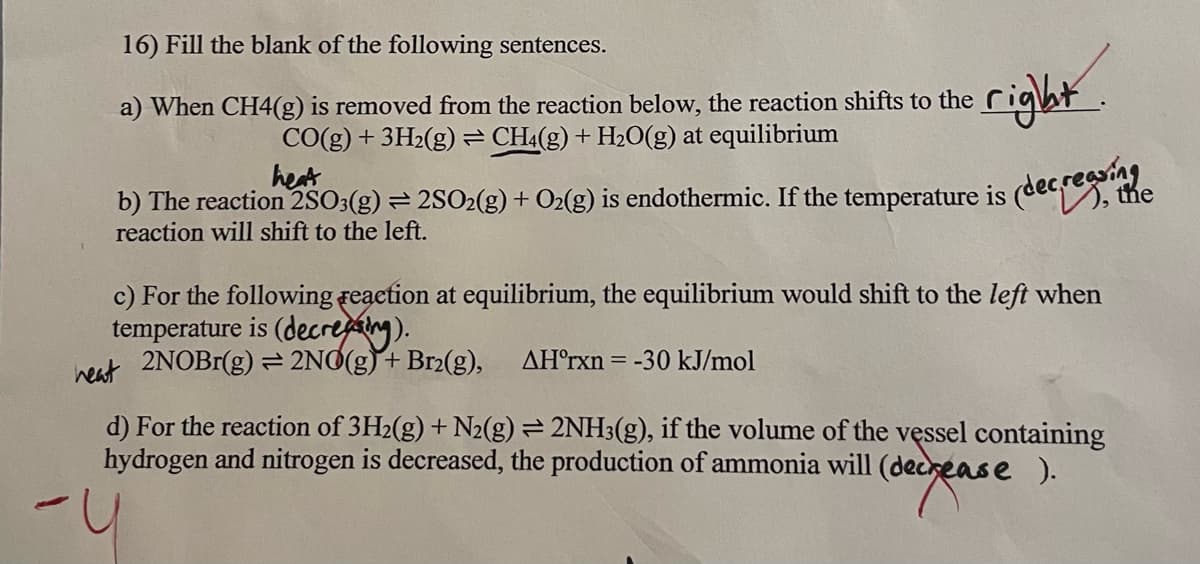16) Fill the blank of the following sentences. a) When CH4(g) is removed from the reaction below, the reaction shifts to the CO(g) + 3H₂(g) = CH4(g) + H₂O(g) at equilibrium right. heat b) The reaction (2503(g) = 2802(g) + O2(g) is endothermic. If the temperature is (decreasin the reaction will shift to the left. c) For the following reaction at equilibrium, the equilibrium would shift to the left when temperature is (decreasing). at 2NOBr(g) = 2NO(g) + Br₂(g), AH°rxn = -30 kJ/mol
16) Fill the blank of the following sentences. a) When CH4(g) is removed from the reaction below, the reaction shifts to the CO(g) + 3H₂(g) = CH4(g) + H₂O(g) at equilibrium right. heat b) The reaction (2503(g) = 2802(g) + O2(g) is endothermic. If the temperature is (decreasin the reaction will shift to the left. c) For the following reaction at equilibrium, the equilibrium would shift to the left when temperature is (decreasing). at 2NOBr(g) = 2NO(g) + Br₂(g), AH°rxn = -30 kJ/mol
Principles of Modern Chemistry
8th Edition
ISBN:9781305079113
Author:David W. Oxtoby, H. Pat Gillis, Laurie J. Butler
Publisher:David W. Oxtoby, H. Pat Gillis, Laurie J. Butler
Chapter14: Chemical Equilibrium
Section: Chapter Questions
Problem 89AP
Related questions
Question

Transcribed Image Text:16) Fill the blank of the following sentences.
a) When CH4(g) is removed from the reaction below, the reaction shifts to the
CO(g) + 3H₂(g) = CH4(g) + H₂O(g) at equilibrium
heat
b) The reaction 2SO3(g) = 2SO2(g) + O2(g) is endothermic. If the temperature is
reaction will shift to the left.
(decreasing
the
c) For the following reaction at equilibrium, the equilibrium would shift to the left when
temperature is (decreasing).
heat 2NOBr(g) = 2NO(g) + Br₂(g), AH°rxn= -30 kJ/mol
d) For the reaction of 3H₂(g) + N2(g) = 2NH3(g), if the volume of the vessel containing
hydrogen and nitrogen is decreased, the production of ammonia will (decrease ).
-
(decrease
right.
Expert Solution
This question has been solved!
Explore an expertly crafted, step-by-step solution for a thorough understanding of key concepts.
Step by step
Solved in 3 steps with 3 images

Knowledge Booster
Learn more about
Need a deep-dive on the concept behind this application? Look no further. Learn more about this topic, chemistry and related others by exploring similar questions and additional content below.Recommended textbooks for you

Principles of Modern Chemistry
Chemistry
ISBN:
9781305079113
Author:
David W. Oxtoby, H. Pat Gillis, Laurie J. Butler
Publisher:
Cengage Learning

General, Organic, and Biological Chemistry
Chemistry
ISBN:
9781285853918
Author:
H. Stephen Stoker
Publisher:
Cengage Learning

General Chemistry - Standalone book (MindTap Cour…
Chemistry
ISBN:
9781305580343
Author:
Steven D. Gammon, Ebbing, Darrell Ebbing, Steven D., Darrell; Gammon, Darrell Ebbing; Steven D. Gammon, Darrell D.; Gammon, Ebbing; Steven D. Gammon; Darrell
Publisher:
Cengage Learning

Principles of Modern Chemistry
Chemistry
ISBN:
9781305079113
Author:
David W. Oxtoby, H. Pat Gillis, Laurie J. Butler
Publisher:
Cengage Learning

General, Organic, and Biological Chemistry
Chemistry
ISBN:
9781285853918
Author:
H. Stephen Stoker
Publisher:
Cengage Learning

General Chemistry - Standalone book (MindTap Cour…
Chemistry
ISBN:
9781305580343
Author:
Steven D. Gammon, Ebbing, Darrell Ebbing, Steven D., Darrell; Gammon, Darrell Ebbing; Steven D. Gammon, Darrell D.; Gammon, Ebbing; Steven D. Gammon; Darrell
Publisher:
Cengage Learning

Chemistry for Engineering Students
Chemistry
ISBN:
9781337398909
Author:
Lawrence S. Brown, Tom Holme
Publisher:
Cengage Learning

Chemistry: Principles and Reactions
Chemistry
ISBN:
9781305079373
Author:
William L. Masterton, Cecile N. Hurley
Publisher:
Cengage Learning

Chemistry by OpenStax (2015-05-04)
Chemistry
ISBN:
9781938168390
Author:
Klaus Theopold, Richard H Langley, Paul Flowers, William R. Robinson, Mark Blaser
Publisher:
OpenStax